7 Things you need to know to pack and carry your kit during your commute to work.
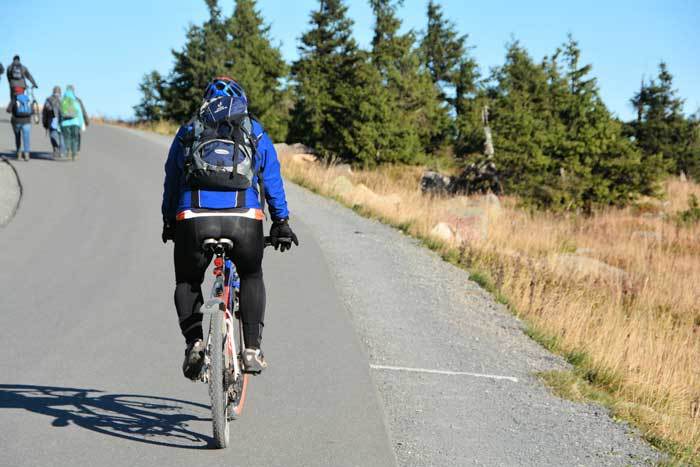
When you’re riding your bike to work, you necessarily have a lot of stuff to bring with you. In addition to a flat kit and other bike maintenance tools in case anything goes wrong along the way, you’re likely to be carrying a computer, spare clothes, lunch food, papers, and anything else you might need during the day.
All of that stuff can add up to a significant amount of weight and volume, so it’s important to have a way to carry it all from your home to work and back on your bike without getting in the way of your ride or risking dropping anything.
Thankfully, there are a wide variety of solutions for bike commuters to carry everything you might need on your bike.
In this article, we’ll cover everything you need to know about how to pack and carry your kit during your commute to work.
Packing
Before you even think about the type of gear you’ll need to carry your stuff, you need to know exactly how much stuff you need to transport and how much space it takes up.
While there are a wide variety of carrying options that allow you to pile a nearly endless amount of stuff onto your bike,
The more you can narrow down your kit and the tighter you can pack and organize it all the less you have to worry about finding multiple carrying solutions that weigh down your bike and mess with your bike’s handling.
Clothes

The first thing that most commuters are sure they’ll need to pack away in a bag is a set of work clothes. Unfortunately, unless your commute is very short and the weather is expected to be perfect, you will need a full set of work attire stashed in a waterproof bag – and maybe even a spare jacket or extra attire for post-work plans.
The key to packing clothes is that most people want to keep their work clothes relatively wrinkle-free, especially if there is no iron at your office. That means that the rolling method, which is traditionally the best for packing clothes tightly, is not ideal. Instead, you can pack your clothes in a “sandwich” by folding your pants in half, then putting your folded shirt over the lower half of the pants, and then folding the pants one more time, so they cover the shirt. Just be sure that this sandwich doesn’t get crumpled when you place it into your bag.
Shoes are bulky no matter how you try to pack them, so if you need to wear a different pair of shoes for work than the shoes you’ll be pedaling in the best solution is to leave a pair of shoes at the office simply. Otherwise, you can stack your shoes together in opposite directions with the soles facing out so that they take up the minimum possible amount of space.
Know How To Dress For Your Cycling Commute here.
Pro Tip:
If you are expecting wet weather, pack your shoes inside a plastic bag. That way, if you go outside for lunch and get your shoes wet, they won’t soak everything else in your carry bag on the trip home.
Food
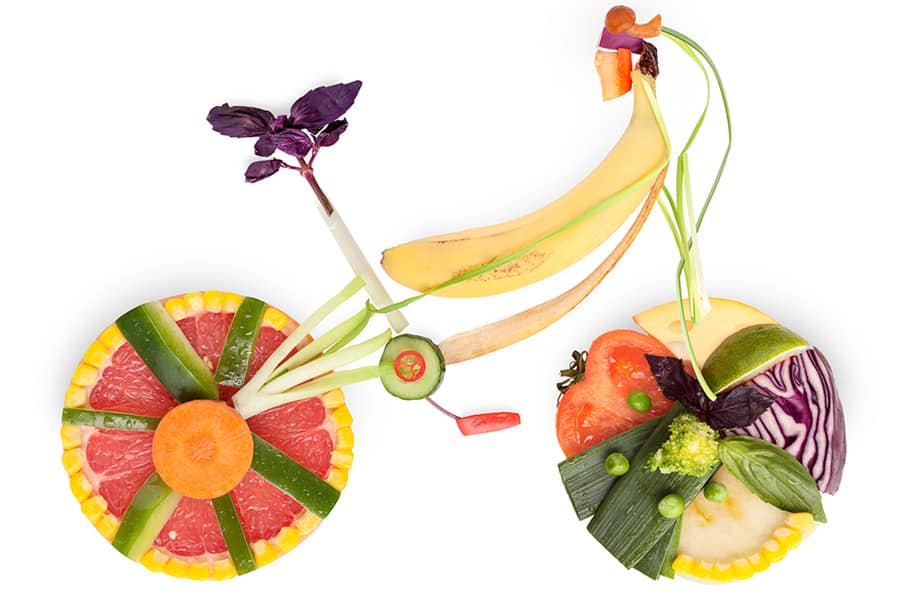
Whenever you are packing food in your bag, you want to be sure that it won’t spill over your clothes or other work materials. The best way to do this is to double-bag it, packing it first in whatever primary container you are using (like a Tupperware container) and then wrapping it again in a plastic shopping bag.
If you are bringing anything that is particularly wet or spill-prone, add a Ziploc bag into the mix, so the mess is contained no matter what. If you want to pack a liquid such as soup, try freezing it the night before so that it can’t spill on your way to work in the morning.
Computer
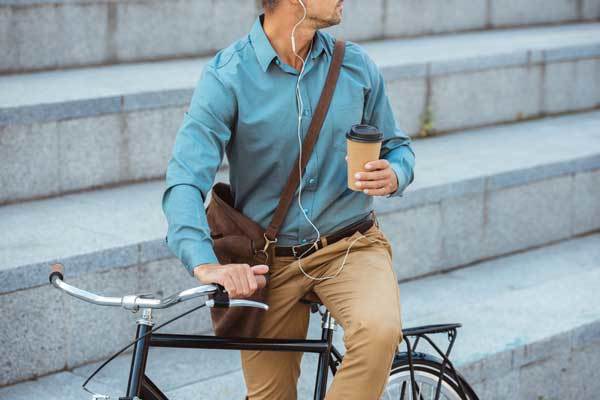
Whenever you are transporting your computer by bike, it’s a good idea to pack it away in a laptop sleeve or similar protective case. While this won’t protect your computer in the event of a crash, it can protect your laptop from being dinged if you ride over bumps or gravel on the way into work or from any spills that might occur inside your bag.
Flat Kit
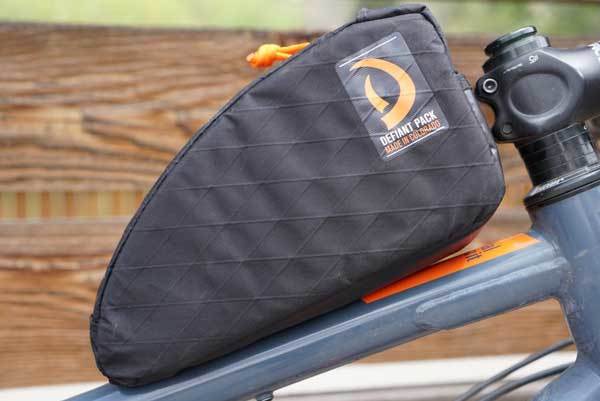
It’s always a good idea to pack a flat kit on your bike whenever you go out for a ride, commutes included. Most cyclists prefer to carry these kits in a small top tube bag, along with any snacks for the ride itself. There’s no secret to packing here – stuff all of the tools you’ll need into the smallest top tube bag you can manage.
Carry Options
Once you have all of the things you’re planning to carry laid out, it’s time to consider carry options. Thankfully, there are a wide variety of options for transporting your stuff on your bike, so you can choose whatever system or combinations of systems work best for your ride.
Backpacks and Messenger Bags

Perhaps the simplest method for getting your stuff to and from work is the everyday backpack or messenger bag. Chances are, you already have a backpack or messenger bag that could work, and it doesn’t require adding any extra hardware to your bike – which means it won’t be in the way if you want to take your bike out for a ride outside your commute.
However, there are some significant downsides to backpacks and messenger bags.
First, a backpack or bag weighed down with your computer, food, and clothing can get heavy quickly. Even when the weight is not overwhelming to lift, this can put a lot of strain on your back when bent over in a riding position – the strain is even worse if you are riding on road bike-style drop handlebars. If you do choose to ride with a pack on, be sure to pack it such that the bulk of the weight is lower in the bag rather than up near your shoulders.
Second, a backpack or messenger bag increases the amount you’ll sweat. Anyone who has tried riding with a pack on a hot day knows the feeling of sweat dripping down your back. If your workplace doesn’t have showers, this can be extremely problematic for your commute.
Finally, most backpacks and messenger bags aren’t designed to be fully waterproof. Road spray and falling rain can quickly soak through the exterior of the bag to leave you with sopping wet clothes and a fried laptop if you forget to check the weather forecast.
Rack and Panniers
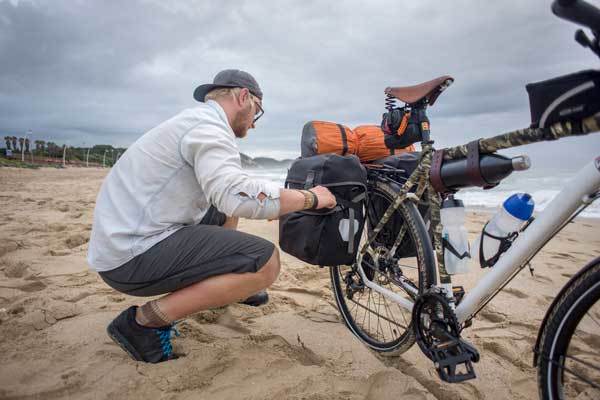
The preferred method for most bike commuters to carry their stuff is the combination of a rear rack and a set of pannier bags. By putting the weight of your stuff on the frame of your bike rather than onto your back, you make your commute significantly easier on your body and reduce the amount of back sweat you’ll generate.
Plus, a rack and pannier system allows you a ton of flexibility when it comes to organizing your stuff and adapting your bags to however much stuff you need to carry – you can easily switch out to smaller or larger panniers, or add panniers to your rack, as needed.
The key when choosing a pannier bag is to find one that is weatherproofed. These bags ride close to the road and pick up a ton of spray when the road is wet in addition to any rain falling from the sky. Depending on what you’re carrying, you may also want to look for a pannier that has multiple pockets rather than one large, cavernous compartment to help with organization.
Finally, when choosing a rack and pannier system, be sure to choose a set that makes it fast and easy to attach the bags onto the rack – especially when you’re running late for work, you don’t want to be fiddling with the attachment mechanism.
Baskets and Crates
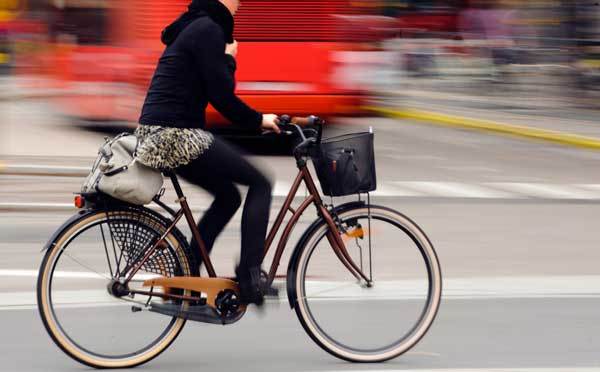
Another common option, prevalent among commuters who pick and choose the days they’ll be riding into work based on the weather, are front-mounted baskets and rear-mounted crates.
These are straightforward carrying systems that, like a pannier set, move the weight of your stuff off of you and onto your bike frame and keeps you from sweating. However, baskets and crates are necessarily open to the weather, so they are typically not the best option for rainy conditions.
The advantage to baskets and crates is that they make it easy to carry large volumes of hard-to-carry stuff such as groceries – which can be a boon for commuters who like to do their shopping on the way home from work.
Pro Tip:
When using a basket or crate, bring a plastic bag or waterproof sack along with you in case the weather forecast is proven wrong.
Commuting to work by bike typically means hauling a significant amount of stuff along with you on your ride.
Read my commuter bikes review here- https://www.rydoze.com/commuter-bikes/
Thankfully, there is a wide variety of carrying systems catered specifically for bike commuters.
With a few packing tips and tricks to keep your stuff dry, safe, and unwrinkled, you can easily find a packing and carrying system that works for your daily commute.

